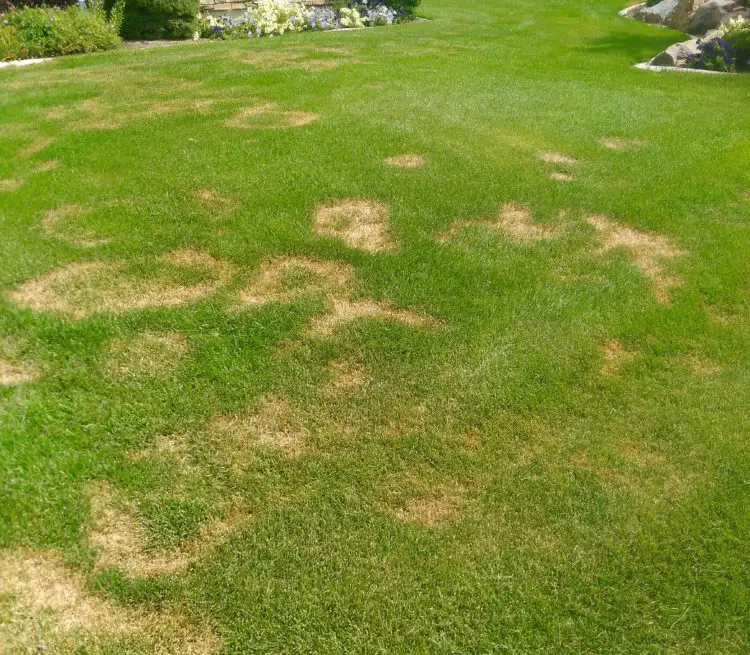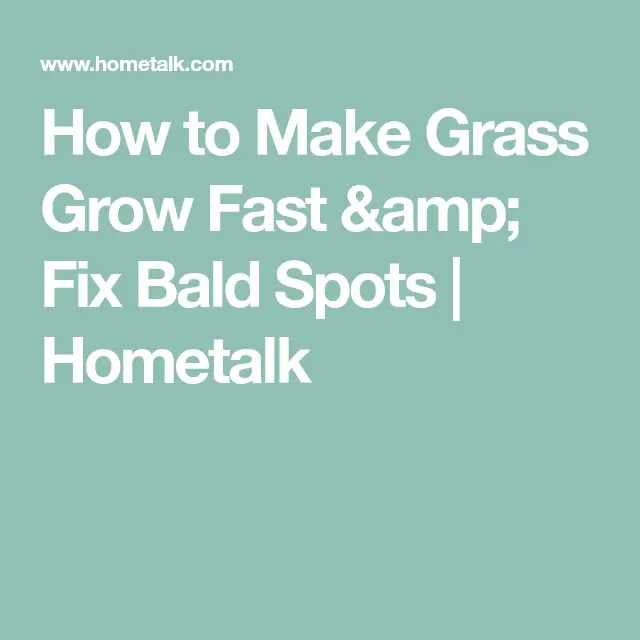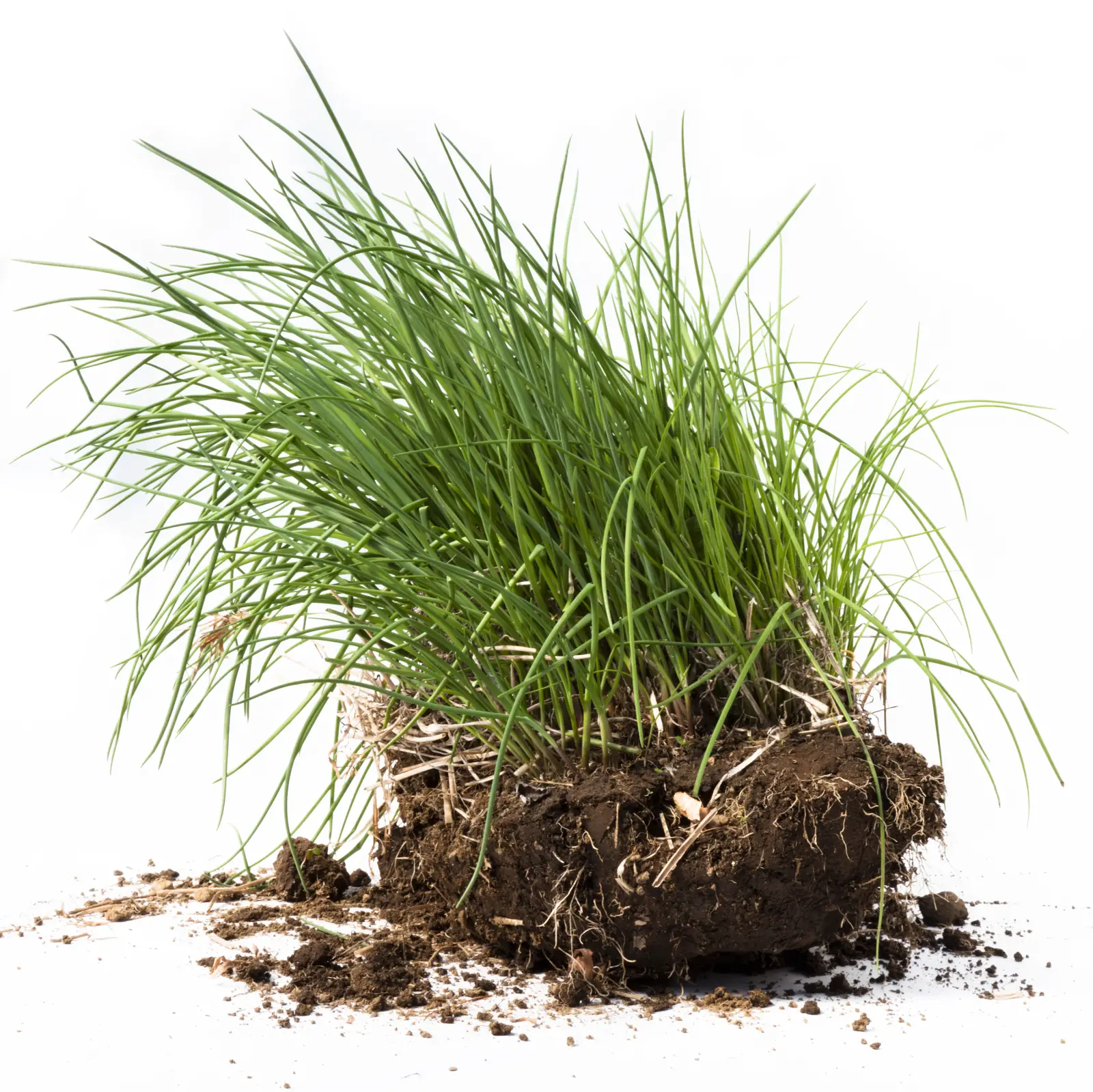How To Plant Grass Seed In Bare Spots
Perhaps you are already familiar with how to seed your lawn. However, reseeding dead spots in a lawn calls for added attention to detail. We have outlined the steps on how to plant grass seed in bare spots for your next lawn repair.
Before you start seeding the brown patch, remove any leaves or debris from the area to avoid damage. This removes any obstacles in distributing the seeds evenly among the dead grass. If the brown patch in your lawn was caused by urine or chemical spills, thoroughly rinse the area several times before reseeding to dilute any harmful chemicals.
- Break up the Soil
Refresh the soil of the brown patch by taking a rake or a garden cultivator to till the ground in your summer yard. This will help ensure that the soil is loose and ready to take in the new seed.
Using compost is a great way to add nutrients back into the soil. Add a 2 to 3-inch layer of compost or loamy soil and use the rake again to mix it with the existing soil.
- Even out the Surface
Use the top of the rake to make a flat and even surface to start sprinkling the grass seed.
Evenly distribute a thin layer of grass seed over your brown patch.
- Protect the Seeds
If you choose to sprinkle the seed on top without pre-mixing it in the soil, place a thin layer of straw over the area to prevent birds from eating the seeds. Once the grass starts to bud, remove the straw.
- Keep the Area Lightly Watered
- Lightly Fertilize
- Monitor the Area
Too Much Fertilizer Water Or Both
Many homeowners inadvertently cause brown spots on their lawn by providing too much of a good thing. For example, fertilizers are great for providing your grass with the nitrogen, phosphorus, and potassium it needs to thrive, and watering your lawn is essential for maintaining health. However, too much fertilizer, too much water, or too much of both can actually cause browning.
Identifying these issues will really require that you pay attention to how often you fertilize, which fertilizer youre applying, and how often youre watering. Symptoms of these issues will look a lot like other problems, including large patches of browning or your entire yard slowly dying off.
How to Fix the Issue
To fix these issues, youll first want to ensure you get your lawn on a proper fertilization and watering schedule. Read the instructions on the fertilizer and make sure youre applying it accordingly. Some slow-release fertilizers should only be put down once per year, while others need reapplication every eight weeks or so. Additionally, you should aim to water your lawn deeply once every two weeks rather than do shallow waterings regularly. You can safely do a deep watering once a week if you live in a hot or dry climate.
Other Reasons Your Grass Is Turning Brown And Dying
- Your lawn may have buried debris thats causing problems.
- Sloping yards could have an erosion issue. Ground covers are a great way to reduce erosion on slopes. Succulents make pretty, easy-to-care for ground covers.
- Tree roots make growing grass tough but you can do it when you use shade-tolerant grasses within your climate zone.
- Different areas of your lawn require different care, and thats especially true of sunny spots. If your grass is turning brown, it could be because its not getting enough water. Lawns typically need an inch of water a week to stay healthy. Picking the right sprinkler for spots in your yard is one of the best ways to keep it healthy.
- If different spots of your yard turned brown, you may just have a mix of grasses. Some grasses will go dormant while others will continue to grow.
Family Handyman
Also Check: Is Aeration Good For Your Lawn
How To Control Brown Patch
Watch the weather forecast for the kind of weather that is conducive to brown patch and treat your lawn for brown patch at the first sign of it. Apply a broad-spectrum control and prevention product like Scotts® DiseaseEX Lawn Fungicide. This is a quick, effective fix that lasts up to 4 weeks and also helps prevent the spread of the disease to the rest of your lawn. Be sure to follow label directions.
Fix Brown Spots In Lawn

Fix Brown Spots In Lawn You love the look of a lush, manicured lawn that turns your backyard into a verdant oasis. But if you have some unsightly dry brown spots, we have good news there is a solution for it.
From faded lawns to bug problems, were here to help you transform your lackluster yard into a green space. Here are eight common lawn grass problems and how to identify and fix each to keep your lawn healthy and beautiful.
Read Also: How To Get Moss Out Of Lawn
How To Fix Dead Grass Areas: What To Do
Having a lush green lawn that the neighbors envy can make you feel good every time you step outside. It looks great, it boosts your curb appeal, and can really put a smile on your face.
But that may not be what youre seeing outside and potentially the reason you found this article. You could have thought you succeeded in growing a great lawn but are now looking at dead, brown spots. Or, you could just now be realizing your lawn has progressively gotten worse and really needs some professional help.
When you start to see dead spots in your grass, it can completely change your mood. Few things can be more frustrating and you want a solutionfast.
Of course, the last thing that you want to do is make the problem worse. There are definitely certain things that you should be doingand other things you should not.
Thats why weve rounded up a handy list of how to get dead grass to growas well as what to avoid doing.
How To Patch Bare Spots With Sod
For a quicker fix than reseeding, try using sod. Sod is a fairly inexpensive way to repair bare spots of dead grass.
Similar to reseeding, remove any leaves, dead grass, weeds, or debris from the brown patch area before getting started.
Using a garden hoe or rake, till the soil a few inches deep to break up the solid pieces of dirt.
- Measure the Area of the Brown Patch
Use a tape measure to evaluate the width and length of your brown patch. Then, purchase a piece of sod from your local gardening store that will fully cover the area.
- Select the Right Turfgrass
Be sure to select the correct turfgrass sod for your lawn, identify the grass you have growing, and try to match this when buying pieces of sod.
Using a sharp shovel or garden tool, cut a piece of sod that is slightly larger than the area you are covering.
- Lightly Fertilize
Applying a small amount of fertilizer to the soil before laying sod will encourage the roots to establish and anchor down the sod piece.
- Firmly Place the Sod Piece
Place the sod on top of the brown patch matching the shape as best you can. Compress the sod down into the lawn by tamping it down with a rake and then immediately walking on it.
- Water the Sod Immediately
The sod will need more water than regular seed grass. Keep the area moist by watering two to three times a day if needed. Monitor the edges of the new sod they will dry out first.
- Hold Off on Weed Control
- Assume Regular Lawn Treatment
Read Also: Where To Buy Super Juice Lawn Fertilizer
Brown Patch Disease Fungus
Lets start with the most obvious of them all lawn fungi! Whether its brown patch disease, spring dead spot, dollar spot, or leaf spot, fungi are a huge detriment to the health of Bermuda grass.
Most of these fungi stay dormant in wait for the perfect conditions for growth and reproduction. The brown patches or dead spots will start to show during the warmth of the hot summer days and the moisture from nighttime irrigation you do on your bermuda grass lawn.
With time, fungal residue inhibits photosynthesis, as the fungi gradually spread across the grass leaves, leaving dead spots on the infested areas. The visual results are patches of brown grass.
| Preview |
|---|
Affiliate links and images pulled from the Amazon Product Advertising API on: 2022-09-21
Drought Or Lack Of Water
Lake of water in areas of the lawn can lead to brown spots. If you irrigation system isnt functioning properly in the heat of summer it can leave areas without the proper water to thrive.
Fix Lack of Water: Monitor your irritation system to ensure proper lawn coverage. You may need to adjust your sprinkler heads or have an irrigation expert check your system.
Recommended Reading: How To Choke Out Weeds In Lawn
Will Baking Soda Neutralize Dog Urine On Grass
A natural way to repair yellow spots in the grass caused by the dogs urine is to dissolve a cup of baking soda in a gallon of water and pour on the affected area. The baking soda neutralizes the high nitrogen concentration, and it will also deodorize the area so the dog wont recognize the spot and go there again.
When To Get Rid Of Brown Patch Fungus
Begin your efforts at brown patch control in the spring, with aeration and dethatching. Application of fungicide should be done when the fungal patches appear, usually mid to late summer, Reseeding with different grass species, where necessary, can be done by over-seeding over several fall seasons, or, if you want quicker results, eliminate the old turf grasses in spring and reseed immediately.
Recommended Reading: How Much Does Lawn Care Make
Foot Traffic Or Furniture
High wear can make it hard for your grass to grow. If your family and pets often tread the same route through your hard, this consistent traffic may create dead patches.
Leaving patio furniture, toys, or anything else on your grass for even a weekend can block sunlight and water from reaching the roots of your grass, causing dead spots. Almost anything, if left for long enough, can damage grass tarps, kiddie pools, chairs, or cars can leave behind a brown patch in their wake.
How to Prevent it
Reroute where your family and pets walk to give your grass a break. Also consider installing a stone, gravel, or mulch path where your family walks frequently.
To help grass under a trampoline stay healthy, one trick is to put a sprinkler underneath it whenever its not in use to make sure it still gets water. If youre going to put out a temporary pool, put it over a tarp first and try to move it around the yard throughout the summer so no one area gets too much damage.
How To Fix Dog Urine Spots On Lawns

Sharing your yard with a canine companion can be one of the best parts of having a lawnuntil dog urine lawn spots and other dog damage show up in your carpet of green. By learning how to fix dog urine spots on lawns and prevent other dog-related lawn damage, you and your dog can coexist harmoniously and enjoy a beautiful, lush lawn.
Get your four-legged buddy on board and follow these basics for simple, effective dog urine grass repair:
Donât Miss: How To Kill Wild Violet Weeds In Lawn
Recommended Reading: How To Lower Lawn Ph
How To Fix Dead Grass
Foot traffic and weather extremes like drought and flooding can damage your lawn, leading to patches of dead grass. Repair these spots for a lush lawn spring, summer and fall.
This simple process requires just a single product, and depending upon the number of patches, not much of your time. Start with a grass seed product that combines seed, fertilizer and mulch.
How To Repair Dog Holes And Other Lawn Damage
Dogs, especially puppies, have a lot of energy that they often devote to digging. They may dig for entertainment, to try and escape, or to hunt prey such as moles.3 It can take some time to train your dog to stop digging once they develop the habit, so intervene earlywith attention, training and praiseto stop digging problems right away.
Step in with quick lawn repairs to fix digging holes as soon as they appear:
For other lawn areas hit with doggy damage, turn to Pennington Lawn Booster. This all-in-one product combines premium Pennington Smart Seed, professional-grade fertilizer and soil enhancer. It’s guaranteed to grow quicker, thicker, greener grass in just one application.
Pennington, One Step Complete and Smart Seed are registered trademarks of Pennington Seed, Inc.
Read Also: When To Fertilize Lawn In Houston
Is Dog Pee Good For Soil
The problem is that most dog owners have not only trained their pups to pee onto trees, they think it is good for them. It isnt. The old trope that canine urine is a fertilizer is but a fertile lie: While urea is rich in nitrogen, and plants require nitrogen for leaf growth, urea is also rich in salt.
Symptoms Of Fertilizer Burn
Fertilizer burn varies by severity, but it always has roughly the same symptom: discoloration.
Mild fertilizer burn is when your lawn starts to yellow slightly or has brown streaks through it. When you touch mildly overfertilized grass, itll still feel flexible and wont break when you bend a grass blade.
With severe fertilizer burn, the grass will turn a shade of brown or tan. In severely overfertilized grass, the blades also become brittle and break if you attempt to bend them.
Also Check: Best Treatment For Creeping Charlie
You May Like: When’s The Best Time To Fertilize Your Lawn
Another Cause Of Brown Grass: Dont Use A Dull Mower Blade
Dull mower blades rip through the grass blades instead of slicing them cleanly, and that stresses the plant. You can always tell a lawn thats been mowed with a dull blade because it looks brown on the top. Get on your hands and knees and you can actually see the damage. Be sure to sharpen your mower blade each season to keep your lawn in good shape.
Getting Brown Spots In Your Lawn Causes + How To Get Rid Of Brown Patch Fungus
Alex K.Affiliate Disclaimer: My content may contain links to products I use and love. As an Amazon Associate and participant in various other affiliate programs, I earn a small commission at no extra cost to you from qualifying purchases. I only recommend products I personally vetted!
The common causes of brown spots in lawns include excessive shade, soil compaction, and aeration problems, lawn fungus infection, and dormancy. You can easily get rid of these brown patches by treating lawn fungus, aerating your lawn, and reducing shade.
Are you getting sick and tired of the unsightly brown patches of grass on your once beautiful lawn? While many automatically assume brown patches in a lawn with brown patch fungi a common Bermuda grass disease the reality is that these brown patches can be caused by a range of factors.
Each of the causes calls for their own unique fix or preventative measures. Therefore, before you rush to purchase a can of anti-fungal pesticide for your lawn thinking youve got a case of brown patch fungi, you might want to consider the actual cause first.
You May Like: When To Aerate Lawn Oklahoma
Human And Animal Damage
Unfortunately, its very easy for us to damage lawns. Some common causes of brown spots on lawns include:
Dull Mower: Dull mower blades tear your grass, causing damage and gradual death to the grass.
Remedy: Sharpen your blades in fall and spring. After mowing, examine your grass to see if the mower is cutting cleanly.
Scalping: If your mower blade is set too low or there are lumps in the lawn, it can cut the grass too short and cause damage.
Remedy: Practice proper mowing techniques by raising your mower blades, and smooth out high spots by digging up the sod, removing some of the soil underneath, and replacing the sod.
Chemicals: Gasoline, fertilizer, herbicides, and pesticides can cause dead spots if spilled. If fertilizer is applied unevenly or incorrectly, it can burn the grass. Even insect repellents can burn your lawn when sprayed on the grass blades.
Remedy: Pour chemicals, fuels, and sprays on your driveway, not on your lawn, and follow application directions.
Animal Urine: Dogs are the most common culprit, but large birds and other animals can cause urine spots, too. Urine usually causes your lawn to turn yellow in spots, sometimes with a bright green ring around the edges where the diluted nitrogen in the urine acts as a fertilizer.
Remedy: Check out our article on How to Keep Dogs From Damaging Your Lawn for tips.
How To Identify Brown Patch

If your lawn has begun to yellow rapidly, take a closer look at the size and shape of the affected areas. With brown patch, they are likely to be roughly circular, though a bit irregular. Patch sizes can range from a few inches to several feet in diameter. If brown patch has been active for a while, the spots might also look like patches of good grass with rings of dead or thin grass around them.
Besides yellow, do you notice any other colors in the patchy areas? Brown patch patches can be darker purple or burgundy on the outside, for example. Other signs include irregular tan spots bordered by a darker outline on grass blades, brown and shriveled blades, rotting at the base of the blades, darker blades that look water-soaked, and possibly white, cobweb-like growth around the blades .
Also Check: How To Aerate Lawn Yourself